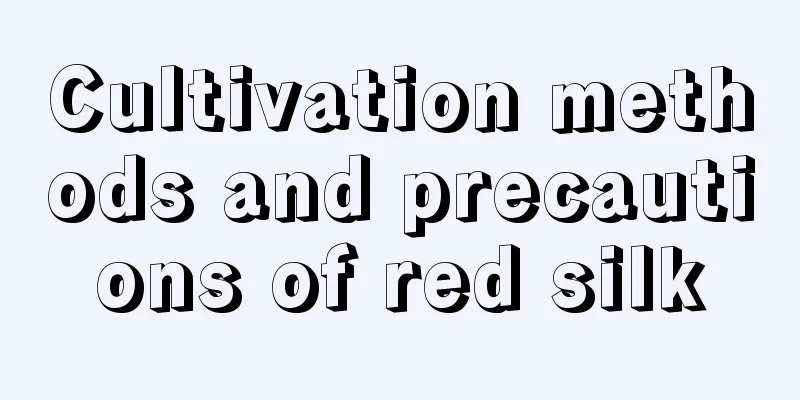Cultivation methods and precautions of red silk

1. Maintenance methods1. Soil: Loose, porous soil with good drainage should be used for growing red currant. You can mix leaf mold with coarse sand and some bone meal. The soil prepared in this way is conducive to the breathing of plant roots and is not compacted or heavy. 2. Light: The growth of red currant requires sufficient sunlight. Good lighting conditions should be provided for the plant regardless of the growth period or the maintenance period. A well-lit environment is very beneficial to the growth of red currant, which will cause its leaves to change from green to light purple, thus making it have extremely high ornamental value. 3. Temperature: The suitable temperature for the growth of red currant is 18-22℃. When caring for the plant, you should avoid direct sunlight, pay attention to cooling in summer, and keep warm in winter, and avoid placing the plant in an environment below 5°C. 4. Water: During the growth period of the red curl plant, care should be taken to keep the soil in the pot moist. You can water more, but control the amount to avoid waterlogging in the soil. The temperature is lower in winter and water evaporates slowly, so watering should be reduced to avoid frost damage. 2. Breeding techniques1. Fertilization: When the red curled jasmine is in the growth period, it should be ensured that fertilizer is applied once a month. Fertilizer can be used in the form of diluted fertilizer cake water or 15-15-30 special fertilizer for potted flowers. Be careful to avoid applying fertilizer to the center of the leaves. 2. Repotting: The red currant plant needs to be repotted every 1-2 years. Repotting can be done in spring, and the use of well-drained and breathable soil is conducive to the growth of red currant. 3. Problem diagnosis and treatment1. Summer period: When raising red curly bean, care should be taken to avoid exposure to sunlight during the summer. When the temperature is too high, cooling methods must be adopted, but be careful not to use too cold water for watering. Watering should be done in the morning and afternoon, and windows should be opened more often to avoid the room being too stuffy. 2. Hydration: When cultivating red currant, if you do not pay attention to problems such as insufficient sunlight, excessive water accumulation, frostbite, diseases and insect pests, it will lead to its hydration and death. Therefore, the plants should be given sufficient sunlight, avoid rain and excessive watering that causes water accumulation at the roots, and keep warm in winter. If pests and diseases are found, the water-soaked parts should be cut off, applied with carbendazim, dried, and carefully maintained. 4. Other issues1. Can it be cultivated indoors? Because the red curly bean likes light, and its leaves can only turn into a unique light purple color in an environment with good lighting, it is recommended to cultivate it in an indoor environment with good lighting. And a ventilated environment must be ensured. If the light and ventilation are poor, it is recommended to cultivate outdoors. 2. Is it edible? There is no information showing that the red currant is poisonous, but it is still best not to eat it. |
<<: Black wolfberry cultivation methods and precautions
>>: Cauliflower cultivation methods and precautions
Recommend
Jabuticaba propagation and pruning
Habits Jabuticaba cannot grow without water. Trop...
The best time to pick wild mugwort leaves
1. Why choose the best time to pick When harvesti...
How to make gardenia grow buds
1. Suitable substrate Choosing the right substrat...
What to do if wintersweet root rots
1. Prevention methods 1. Water appropriately Reas...
How to grow Dancing with the Wind hydroponically? Does it like sunlight?
1. Water culture and maintenance methods 1. Chang...
The profit per mu of sea gold sand planting is how much profit can you make by planting one mu of sea gold sand artificially?
The price of sea sand is relatively expensive. It...
Do I need to water the crabapple more when it blooms? What should I do if it dries up after a few days of not watering?
1. Do you need to water more during the flowering...
What can't be eaten with lemon?
1. Seafood The rich calcium in seafood reacts wit...
Can Fuchsia be hydroponically cultivated?
1. Is it possible to grow hydroponically? Some fr...
How to fertilize lily
1. Potted plants If it is a potted plant, use rot...
How to prune potted gardenias
When to prune gardenias It is generally more appr...
How to raise black magic master in winter
1. Breeding methods 1. Temperature: First of all,...
Why do orchids not germinate? How can we grow them to germinate more?
1. What is the reason for no germination? 1. Lack...
Can the willow of money be planted at the doorstep?
Can the Willow of Money be planted at the doorste...
In early autumn, quickly peel the flowers and one pot can be turned into 20 pots in seconds, saving a lot of money!
Break off the side buds and turn 1 pot into 10 po...









